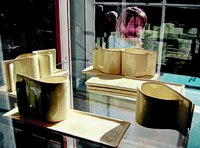Contemporary European Ceramics on Bornholm
Štefan Oriško
In September and October 2006 the Danish island of Bornholm hosted a series of exhibitions of contemporary ceramics entitled the European Ceramic Context. The exhibitions were unusual not only within the Danish context but also in the overall European one. They were divided into three parts: exhibitions dedicated to renowned authors, to the young generation, and to ceramic design. Individual European countries were allowed two representative authors with two works in each category. The organizers left the choice of work as well as the authors to the participating countries. They invited everyone to the island of Bornholm, where on the 8 September the varied international selection started its journey to the individual exhibitions in various cities on the coast. The highlight of the exhibition was the announcement of prizes for the individual categories. Even though the Bornholm exhibitions had the character of a competition (similar to other ceramic exhibitions), the main focus was for general familiarization with contemporary European ceramics. The exhibition category for established ceramic makers took place at the Bornholm Museum of Art (Kunstmuseum) close to the city of Gudhjem. It showcased the work of authors from the middle to older generation. The exhibition was an opportunity to demonstrate that the borders of European ceramic artist generations had grown and that not only were they part of the process but they also enriched the whole field with their works. Slovakia was represented by Anna Horváthová and Ivica Vidrová-Langerová with their works originally created at domestic symposia, a point which is definite proof that these meetings are very important as creative workshops.
If in previous decades there were certain regional differences to be seen in modern European ceramics through local traditions, now local connections from the point of view of the youngest generation have almost ceased to exist since language, or better to say the many ceramic languages, have became internationalized and their selection has become personal choice. The rich exchange of experience has influenced the internalizing process: an important place in the short biographies of authors starting out is dedicated to stays in European as well as overseas schools (this can be seen in the biographies of the Slovak exhibitors – Edita Balážová and Ján Ševčík). The Bornholm exhibition for the young generation was accepted openly and spontaneously at the exhibition; the authors as well as their works were discussed. Clay is no longer the dominating media in the perception of the youngest generation; it is only one of the elements that can be connected to other materials without prejudice. Using found objects (not always ceramic ones) is a common theme approach, but a technique which was used much more conservatively in previous generations. The exhibition of the youngest took place in the House of Crafts (Grønbechs Gård) in the fishing town of Hasle.
Probably the most complicated category in the Bornholm exhibitions was ceramic design: the selection criteria were adjusted only after the start. This demonstrated that not every European country has a ceramic industry with mass production facilities. After easing the criteria, works intended for small series workshop production were accepted provided they fulfilled the conditions for standardization. Apart from specific company products, designs with a production perspective were also included in the exhibition. Therefore, the designs and works of Ivica Markovičová inspired by ceramic making from Pozdišovce could be presented at the exhibition. These works were created for ÚĽUV’s Rings on Water competition and are intended for workshop art and craft production, even though there is no ceramic industry in Slovakia. The exhibition was installed in the area of the Ceramic Museum in Rønne and in the former family manufacturing facility (Hjorths Fabrik) where you can still find real production.
Apart from the exhibitions, the Bornholm event was accompanied by workshops for students of ceramic schools (again also with Slovak representatives), a conference, and a market for local ceramic makers. The exhibition is documented in a three-part catalogue. According to initial indications, the exhibition was undoubtedly a success and will possibly continue in a two-year cycle.
